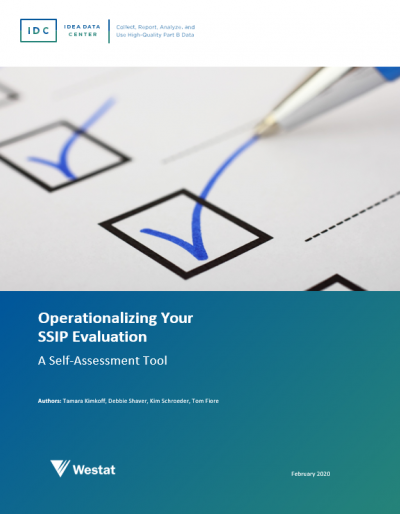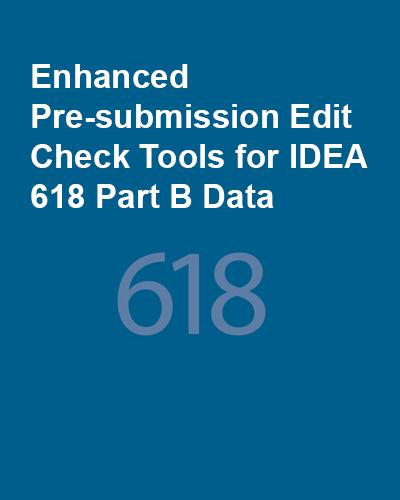
Resource Library
Guides. Briefs. Toolkits. Quick reference information. IDC and its partners created these data quality resources to help states better prepare to address their existing or emerging IDEA data quality needs. Use our search and filtering tools to navigate the library.
Resources 22 - 28 of 88
Format: Guides and Briefs
Operationalizing Your SSIP Evaluation: A Self-Assessment ToolThe purpose of this tool is to lead those within a state responsible for implementing their SSIP evaluation through the process of operationalizing their SSIP evaluation plan in tandem with implementation efforts. State staff can use this interactive self-assessment to gauge their team’s progress on key components necessary for fully executing their SSIP evaluation plan and to identify action steps needed to realize the greatest benefit from their evaluation efforts.
Format: Guides and Briefs
Collecting and Reporting the New Data Elements Related to the Local Education Agency Maintenance of Effort ProvisionsProduced by IDC and CIFR, this resource discusses each of the four new data elements OSEP is adding related to the LEA MOE provisions of IDEA in the MOE Reduction and CEIS data collection. The resource reviews each new element, presents information about actions the SEA may take to address and answer the questions posed for each of the four data elements, and provides additional support and assistance as states prepare to collect and submit these data.
Format: Applications and Spreadsheets
IDEA Part B Indicator 12 Transition Template: Calculating Data WorksheetThe tool converts state and LEAs early childhood transition data into percentages. Use of the tool enables states to see real-time percentages of children ages 3-5 in the transition reporting categories and compare the percentages of children within the categories across LEAs.
Format: Applications and Spreadsheets
IDEA Part B Confidentiality ChecklistThe IDEA Part B Confidentiality Checklist can aid state and local agencies in identifying actions, policies, and procedures needed to meet confidentiality provisions outlined in the IDEA Part B, 20 U.S.C. §1400.
Format: Applications and Spreadsheets
SEA Edit Check and Data Display Tools for IDEA 618 Part B DataIDC presents the SEA Edit Check and Data Display Tools for IDEA 618 Part B Data to help states prepare their Part B data submissions. States can use these tools to review the contents of their IDEA 618 EDFacts Part B personnel, exiting, discipline and child count and educational environment data for children ages 3–5 (FS089) and students ages 6–21 (FS002) prior to submission to the EDFacts Submission System or ESS. The tools apply edit checks and identify potential errors in subtotals or totals in the data files. In addition, the tools provide user-friendly summaries of the 618 data. The tools are enhanced versions of the SEA Edit Check and Data Display Tools for personnel, exiting, discipline, and child count and educational environment data. The main difference is the enhanced edit check tools require states to directly copy and paste the EDFacts data files they will submit to ESS as opposed to manually entering data into an Excel file in a format that is different than the one required for submission to ESS.
Format: Guides and Briefs
IDEA Part B Discipline Data Collection Questions and AnswersThe purpose of this document is to assist states with the collection of data on children with disabilities served under IDEA who were subject to disciplinary removal. States can use this document to supplement the instructions provided in the EDFacts file specifications for the EDFacts files that are used to report IDEA disciplinary removal data (C005, C006, C007, C088, C143, and C144).
Format: Quick Reference
A Comparison of Mandatory Comprehensive Coordinated Early Intervening Services (CCEIS) and Voluntary Coordinated Early Intervening Services (CEIS)In December 2016, OSEP finalized new regulations on significant disproportionality (34 CFR §300.646). These regulations enforce the use of IDEA funds for mandatory CCEIS, which LEAs provide upon identification of significant disproportionality, and distinguish use of funds for CCEIS from the use of IDEA funds for voluntary CEIS. This resource is a handy chart that outlines the differences between CCEIS and voluntary CEIS.








